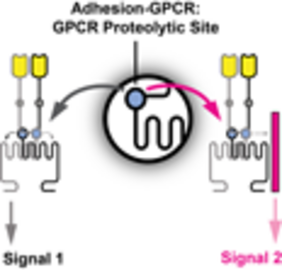The GPS motif is a molecular switch for bimodal activities of adhesion class G protein-coupled receptors
01/01/2012Prömel S, Frickenhaus M, Hughes S, Mestek L, Staunton D, Woollard A, Vakonakis I, Schöneberg T, Schnabel R, Russ AP, Langenhan T (2012)
Cell Reports 2:1-11
Adhesion class G protein-coupled receptors (aGPCR) form the second largest group of seven-transmembrane-spanning (7TM) receptors whose molecular layout and function differ from canonical 7TM receptors. Despite their essential roles in immunity, tumorigenesis, and development, the mechanisms of aGPCR activation and signal transduction have remained obscure to date. Here, we use a transgenic assay to define the protein domains required in vivo for the activity of the prototypical aGPCR LAT-1/Latrophilin in Caenorhabditis elegans. We show that the GPCR proteolytic site (GPS) motif, the molecular hallmark feature of the entire aGPCR class, is essential for LAT-1 signaling serving in two different activity modes of the receptor. Surprisingly, neither mode requires cleavage but presence of the GPS, which relays interactions with at least two different partners. Our work thus uncovers the versatile nature of aGPCR activity in molecular detail and places the GPS motif in a central position for diverse protein-protein interactions.






